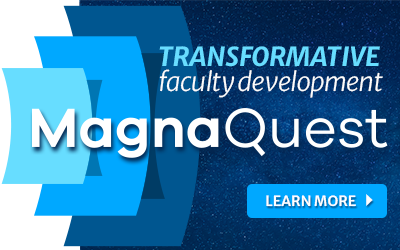As students continue to show interest in taking online courses, and faculty continue to be interested in teaching them, colleges and universities are, in many cases, expanding efforts to increase online programming for their students. This article discusses seven strategies to grow online courses and programs.
Strategy #1 – Strive for faculty buy-in and support.
A number of large and well publicized online initiatives have failed because administrators didn’t ensure faculty were supportive of those ideas. If possible, involve faculty early in campus discussions of online initiatives and priorities. Also, an institution-wide online education committee, with strong faculty representation, is an excellent way to have faculty feel like their voices are being heard. Another idea that might help garner the support of faculty is to enlist them to take the lead on new online initiatives, whether that be expanding online courses or developing new online degrees. Finally, I try to err on the side of faculty. For example, the intellectual property policy at my institution related to online courses and course materials states that faculty retain ownership of all of their online course materials.
Strategy #2 – Offer high quality professional development opportunities for faculty.
One major barrier faculty report for not developing and teaching online courses is that they don’t feel prepared to teach in the online environment. One strategy to overcome that barrier is to provide professional development opportunities related to online course design and facilitation. These opportunities could include one-to-one consultations, institution-wide workshops, and online instructor training courses that often range from two to six weeks in length. It is important to hire appropriate support personnel who are able to provide these opportunities for faculty, such personnel could include instructional designers, instructional technologists, eLearning specialists, media specialists, learning strategists, etc. Additionally, institutions often utilize their own experienced online faculty when planning learning opportunities for others interested in teaching online.
Strategy #3 – Provide exceptional learner support services for online students.
Institutions sometimes underestimate the importance of providing exceptional support for students taking online courses. The expectation from regional accreditors is that online learners will be provided the same high quality learner support services that on-campus students have available to them. These services should be comprehensive in nature and offer support to students from the first time they contact an institution for information, to the point of graduation. Learner support services include admissions, registration, financial aid, technology help, career counseling, academic advising, tutoring, library services, counseling, disability resource services, etc. Sometimes students are not aware of the support services that are available, it is important to promote and share that information with students. Some institutions provide a comprehensive list of learner support services in their online course syllabi.
Strategy #4 – Ensure adequate online administration infrastructure is in place.
Having this “growth” strategy on my list may surprise some, however, I feel that if an institution is going to grow online programming, they should have the administrative infrastructure to assist faculty in making that happen. It is becoming more common to see a dedicated online administrator (e.g., director of online learning) at colleges and universities. Such administrators serve as the point person for all things online. I’ve served in this capacity at my institution for the past ten years and routinely answer questions from, and help faculty, staff, administrators, students, and even parents. Online administrators often take the lead on large projects such as creating an online education policy and procedures manual, ensuring the quality of online offerings, and collecting and disseminating data related to online education.
Strategy #5 – Determining which online courses and degrees to offer.
One strategy my institution uses to determine which online courses could be developed is that we survey online students and ask them which additional courses they would be interested in taking online. Once compiled, that list is shared with department chairs and the registration office. Another strategy we have used is to look at courses that are frequently transferred into our institution and target those courses for online development. In regards to online program development, many institutions have had luck with replicating successful face-to-face degrees in the online format, as the faculty expertise for the degree is already established on campus, and the formal degree approval process is sometimes less onerous as an institution is not offering a brand-new degree, but an existing degree in a different modality.
Strategy #6 – Provide incentives for faculty development and online course development.
Even though approximately 75% of institutions provide faculty some type of incentive for completing online teaching professional development programs or designing online courses, another prominent barrier to faculty developing and teaching online is the belief that inadequate incentives exist for doing so. The belief that online course design and teaching is more work intensive may be the reason for this. Incentives may include additional remuneration, release time from teaching or service work, technology tools (e.g., software, smartpens, ipads), additional recognition for tenure and promotion, and favorable intellectual property policies that allow faculty to maintain the rights to their online course materials. As university administrators factor online learning into the long-term goals and priorities of their institutions, they should provide adequate incentives to faculty to lead those efforts.
Strategy #7 – Keep the focus on quality.
While many institutions have goals and aspirations to grow their online programming, I truly believe that focusing on the quality of online courses and programs will have a greater impact on that growth, especially sustained growth, than any advertising, marketing or promotional campaign could. Over the past ten years I’ve learned that word of mouth spreads incredibly fast, not to mention the speed of information that is shared electronically and through social media. So, if an institution has an inferior product (poor quality online courses and programs) it will be very difficult to grow those offerings. Many things contribute to ensuring high quality online offerings for students, some of which were mentioned above, and others that will be the focus of a future article.
Dr. Brian Udermann will explore these and other related topics during his upcoming Magna Online Seminar “Simple Strategies to Grow Online Courses and Programs“ on January 25, 2018, at 1:00 p.m. (Central Time).



